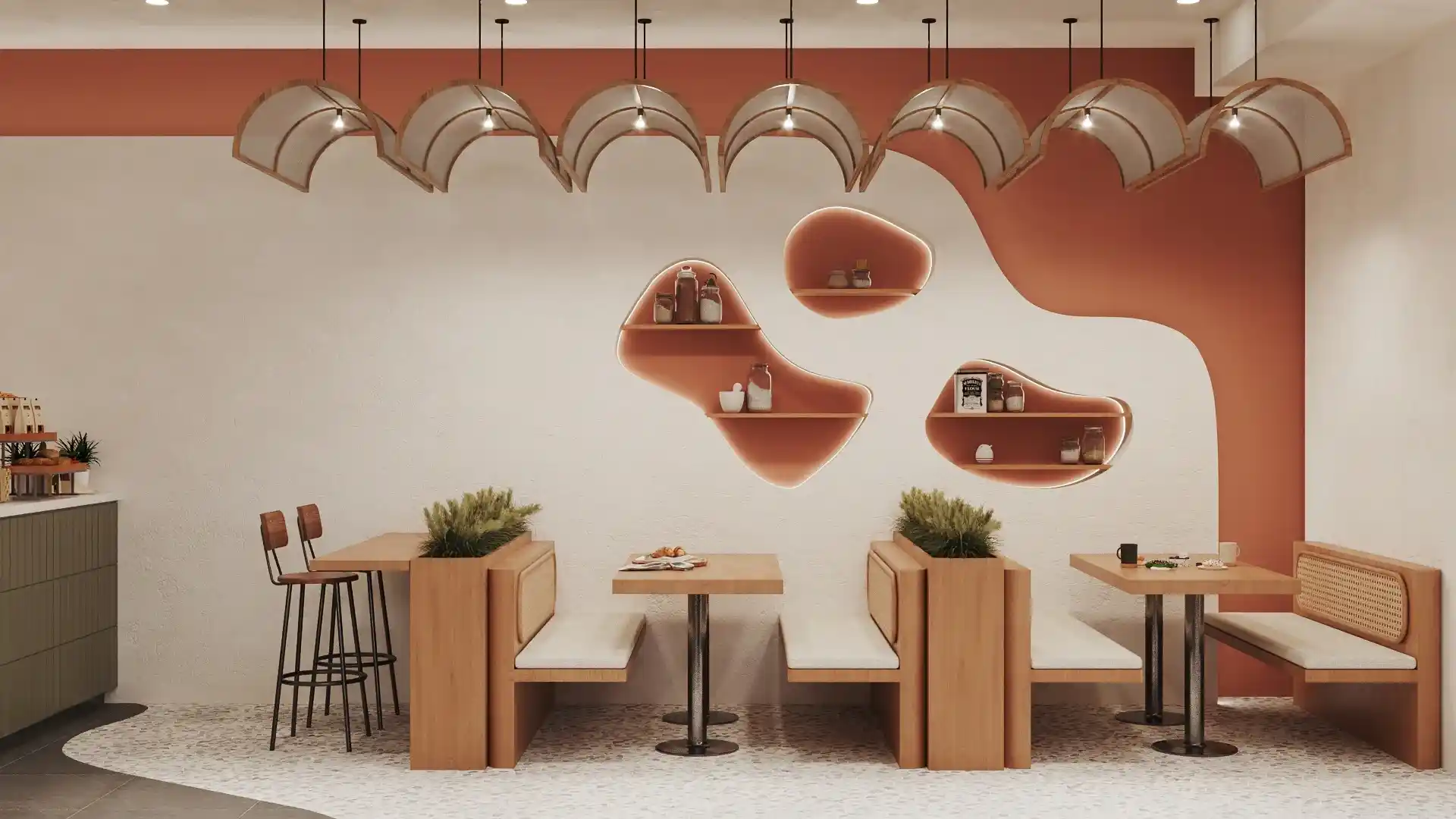Introduction
The ambiance of a café is pivotal in drawing customers in and encouraging repeat visits. A thoughtfully designed space enhances the overall experience, transforming an ordinary coffee break into a memorable moment. Whether you’re launching a new café or revamping an existing one, understanding the key aspects of successful café interior design is essential to creating an inviting and functional space. Partnering with cafe interior designers in Bangalore ensures that your design vision aligns with your brand while meeting your functional requirements. Expert interior design companies can guide you through every step of the process, helping you bring your dream café
The Importance of Café Interior Design
Café interior design is more than just decoration; it’s about creating an experience that aligns with the brand, attracts customers, and keeps them coming back. The design should be a reflection of the café’s identity while also ensuring comfort and functionality. From the choice of furniture to lighting, layout, and color scheme, every detail contributes to the atmosphere and customer satisfaction. Here’s a closer look at the key elements that form the foundation of successful café interior design:
1. Layout and Floor Plan
The layout of your café is one of the most critical aspects of the interior design. A thoughtful floor plan helps create a seamless flow, making it easy for customers to navigate and for staff to serve efficiently. A well-organized layout can also make your space feel larger and more open, enhancing the overall customer experience.
Key considerations for layout design include:
- Seating Arrangement: Create different seating options, such as small tables for individuals, larger ones for groups, and cozy corners for people who prefer privacy. Consider a mix of booths, sofas, and high-top tables to cater to different preferences.
- Traffic Flow: Ensure the layout allows for smooth customer movement without congestion. The barista station should be easily accessible to customers, but not disrupt the flow of traffic.
- Accessibility: Your café should be accessible to all, including people with disabilities. Ensure enough space for wheelchairs and strollers, and have accessible seating options.
Many café interior designers in Bangalore use 3D floor planning tools to visualize the space and make adjustments before committing to the final design. This can be particularly helpful for optimizing small or oddly shaped spaces.
2. Lighting
Lighting plays a pivotal role in creating the right ambiance. It can influence mood, highlight specific areas, and make the space feel more inviting. Café lighting should be functional but also aesthetically pleasing, enhancing the café’s overall vibe.
Lighting tips for a successful café interior design:
- Ambient Lighting: This is the general lighting of the café. It should be bright enough to create a welcoming atmosphere but not too harsh. Consider using pendant lights or chandeliers to add visual interest.
- Task Lighting: Use task lighting above workstations or tables to create a functional space where customers can read, work, or enjoy their food.
- Accent Lighting: Accent lighting can be used to highlight artwork, décor, or architectural features, drawing attention to specific areas of your café.
Pro tip: Natural light is always a winner. Large windows, skylights, or glass walls can let in natural sunlight, which is a big draw for customers, especially during the daytime. If natural light is scarce, focus on adjustable lighting that can change the mood from day to night.
3. Furniture and Seating
Café furniture should be comfortable, durable, and fit well within the overall design theme. The seating arrangement is not just about comfort—it’s about how well it complements the café’s brand and aesthetic.
Key considerations when choosing furniture:
- Comfort: Ensure chairs, benches, and tables are comfortable for extended sitting. The furniture should offer back support and be cushioned where appropriate.
- Durability: Café furniture faces a lot of wear and tear, so it’s essential to select sturdy and durable pieces that can withstand heavy use.
- Design and Style: The furniture should complement the café’s theme, whether it’s modern, vintage, minimalist, or rustic. Look for furniture that matches the mood you want to convey. For example, a cozy, intimate café might use plush armchairs, while a modern café could opt for sleek, metal chairs and tables.
Many interior design companies suggest using multi-functional furniture, such as tables with built-in storage or stackable chairs, especially for smaller spaces.
4. Color Scheme and Theme
The color scheme of a café has a profound impact on the mood and energy of the space. The right colors can stimulate appetite, encourage relaxation, or create a vibrant, energetic atmosphere. Your café’s theme should be consistent with its brand and target audience.
Popular color schemes and themes for cafés:
- Warm tones (reds, oranges, yellows) create a cozy, inviting environment. These colors are known to stimulate appetite and can be great for cafés serving food.
- Neutral tones (beiges, whites, greys) offer a minimalist aesthetic and provide a calm, soothing atmosphere. These are often used in modern or Scandinavian-style cafés.
- Bold contrasts (black and white or dark and light accents) work well for more contemporary, edgy designs.
Incorporating the café’s branding colors into the interior design can help create a cohesive look that is instantly recognizable to customers.
5. Decor and Accessories
Decor and accessories are the finishing touches that personalize your café and reflect its identity. The right décor can also serve as a conversation starter and give your space a unique character.
Decor ideas for a successful café interior:
- Artwork: Hang local art, photographs, or unique pieces that tie into the café’s theme. This adds visual interest and can even serve as an Instagrammable moment for customers.
- Indoor Plants: Incorporating greenery into your café design not only improves air quality but also adds a refreshing, lively touch to the space. Consider plants like succulents, ferns, or hanging plants to add dimension to your café.
- Wall Features: Exposed brick, wooden panels, or geometric wall designs can add texture and warmth to the space, making it more visually appealing.
When selecting decor, consider elements that are easy to maintain. Items like artificial plants or wipeable wall art can reduce the maintenance required while still looking great.
6. Acoustic Design
Noise levels are an often-overlooked aspect of café interior design. Too much noise can make the space uncomfortable, while too little can make it feel lifeless. Balancing acoustics is key to creating a pleasant atmosphere.
Acoustic design tips:
- Soft furnishings: Use cushions, upholstered furniture, and drapes to absorb sound and minimize echoes.
- Acoustic panels: In larger cafés, consider installing acoustic panels or soundproofing materials on walls and ceilings to reduce noise.
Cafés that encourage long stays, such as those with a reading corner or coworking space, can benefit from quieter environments. Softer acoustics are ideal for fostering a relaxing ambiance.
7. Branding Integration
A café’s interior design should reflect its brand and create an immersive experience for customers. From the logo on the wall to the menu design and staff uniforms, everything should feel cohesive and on-brand.
How to integrate branding into your café interior design:
- Logo and Signage: Incorporate the logo prominently in the interior design. This can be on the wall, at the counter, or even on custom furniture.
- Consistent Theme: Ensure that the design elements (furniture, colors, décor) align with the café’s brand identity. For example, a vintage café might use retro furniture, while a minimalist café might favor clean lines and neutral colors.
Strong branding can make your café stand out in a competitive market and build customer loyalty.
8. Technology Integration
Modern cafés often integrate technology to improve both customer and staff experience. From ordering systems to music control, technology should enhance the café experience without overpowering the atmosphere.
Technology tips for café interior design:
- Point of Sale (POS) Systems: Use sleek, efficient POS systems that blend with the interior design. Mobile payment options and self-service kiosks are becoming increasingly popular.
- Wi-Fi and Charging Stations: Offer free Wi-Fi and charging stations for customers who want to work or stay longer. Ensure these areas are easily accessible but not in the way of the café’s flow.
- Music and Sound Systems: Choose a sound system that delivers high-quality audio without being intrusive. Some cafés even have curated playlists that match the vibe of the space.
Digital screens for menus or promotions can be a modern touch, especially for cafés that want to offer dynamic content.
Conclusion
Designing a successful café interior involves balancing functionality with creativity. Every element, from the layout and furniture to lighting, décor, and technology, should be carefully considered to create an inviting, comfortable, and visually appealing space. When working with café interior designers in Bangalore, it’s important to communicate your vision clearly, as they can help bring your ideas to life while ensuring the space is practical and aesthetically pleasing. Additionally, partnering with experienced interior design companies can guide you through the process, offering valuable expertise to ensure your café not only stands out but also provides an unforgettable




